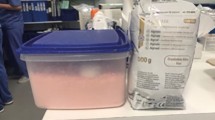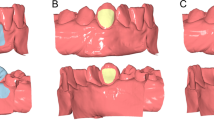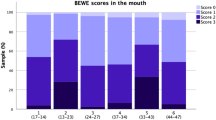Key Points
In this part, we will discuss
-
Surveyor attachments
-
Guide surfaces
-
Paths of insertion and displacement
-
Surveying sequence
-
Indications for tilting a cast
-
Positioning retentive clasps
-
Recording the orientation of a cast
New publications:
All the parts which comprise this series (which will be published in the BDJ) have been included (together with a number of unpublished parts) in the books A Cinical Guide to Removable Partial Dentures (ISBN 0-904588-599) and A Clinical Guide to Removable Partial Denture Design (ISBN 0-904588-637). Available from Macmillan on 01256 302699

Abstract
This article describes the clinical objectives and procedures for surveying a dental cast prior to designing an RPD
Similar content being viewed by others
Main
The surveyor was first introduced to the dental profession in 1918. This instrument, which is essentially a parallelometer, is one of the cornerstones of effective RPD design and construction. The surveyor allows a vertical arm to be brought into contact with the teeth and ridges of the dental cast, thus identifying parallel surfaces and points of maximum contour.
Ideally the clinician, rather than the dental technician, surveys the study cast in preparation for designing an RPD. It is this design, produced in the light of clinical knowledge and experience, which guides decisions on pre-prosthetic treatment and which is ultimately sent as a prescription to the dental technician, who constructs the denture accordingly.
There are several different attachments that may be used with the surveyor.
Analysing rod
Graphite marker
The graphite marker is moved around the tooth and along the alveolar ridge to identify and mark the position of maximum convexity (survey line) separating non-undercut from undercut areas.
When surveying a tooth, the tip of the marker should be level with the gingival margin allowing the side of the marker to produce the survey line as shown in the illustration.
A false survey line will be produced if the tip of the marker is incorrectly positioned. In this example there is not, in fact, an undercut area on the tooth although an incorrect surveying technique has indicated one. If this false line is used in designing an RPD, errors will arise in the positioning of components, especially clasps.
Undercut gauge
Gauges are provided to measure the extent of horizontal undercut and are available in the following sizes: 0.25 mm, 0.50 mm and 0.75 mm. By adjusting the vertical position of the gauge until the shank and head contact the cast simultaneously, the point at which a specific extent of horizontal undercut occurs can be identified and marked. This procedure allows correct positioning of retentive clasp arms on the tooth surface as described in Chapter 6 of our publication – 'A Clinical Guide to Partial Denture Design'.
Other, more sophisticated, types of undercut gauge are available such as dial gauges and electronic gauges. These attachments fulfil the same function as the simpler type of gauge.
Trimming knife
This instrument is used to eliminate unwanted undercuts on the master cast. Wax is added to these unwanted undercut areas and then the excess is removed with the trimmer so that the modified surfaces are parallel to the chosen path of insertion. A duplicate cast is then made on which the denture is manufactured. Such a procedure eliminates the problem shown in Fig. 7.
When elimination of undercuts is required on a cast which is not to be duplicated, a material such as zinc phosphate cement, which can resist the boiling out procedure, is used. The surveyor is used to shape the cement before it is fully set.
The trimming knife can also be used to prepare guide surfaces (Fig. 9) on wax patterns of crowns for abutment teeth.
Before discussing the functions of a surveyor in more detail it is necessary to explain the following terms:
-
Guide surfaces.
-
Path of insertion.
-
Path of displacement.
Guide surfaces (or guide planes)
Path of insertion
The path followed by the denture from its first contact with the teeth until it is fully seated. This path coincides with the path of withdrawal and may or may not coincide with the path of displacement (Fig. 15). There may be a single path or multiple paths of insertion.
Path of displacement
Surveying procedure
This may be divided into the following distinct phases:
-
Preliminary visual assessment of the study cast.
-
Initial survey.
-
Analysis.
-
Final survey.
Preliminary visual assessment of the study cast
This stage has been described as 'eyeballing' the cast and is a useful preliminary to the surveying procedure proper. The cast is held in the hand and inspected from above. The general form and arrangement of the teeth and ridge can be observed, any obvious problems noted and an idea obtained as to whether or not a tilted survey should be employed.
Figs 16 and 17 – Assessment of the study cast
Initial survey
The cast is positioned with the occlusal plane horizontal. The teeth and ridges are then surveyed to identify undercut areas that might be utilised to provide retention in relation to the most likely path of displacement. The position of the survey lines and the variations in the horizontal extent of undercut associated with them should be noted. The amount of undercut can be judged approximately from the size of the 'triangle of light' between the marker and the cervical part of the tooth, or measured more precisely by using an undercut gauge. An assessment can then be made as to whether the horizontal extent of undercut is sufficient for retention purposes.
Analysis
An RPD can be designed on a cast which has been surveyed with the occlusal plane horizontal (ie so that the path of insertion equals the path of displacement). However, there are occasions when tilting of the cast is indicated so that the paths of insertion and displacement differ.
Before deciding if the cast should be tilted for the final survey the graphite marker in the surveyor is changed for an analysing rod so that various positions of the cast can be examined without marking the teeth.
The analysis of the cast continues with the occlusal plane horizontal and the following aspects, one or more of which might necessitate a final survey with the cast tilted, are considered:
-
Appearance.
-
Interference.
-
Retention.
Appearance
When a maxillary cast, containing an anterior edentulous area, is surveyed with the occlusal plane horizontal it will often be found that there are undercuts on the mesial aspects of the abutment teeth. If the RPD is constructed with this vertical path of insertion there will be an unsightly gap between the denture saddle and the abutment teeth gingival to the contact point.
Interference
While examining the cast with the occlusal plane horizontal, it sometimes becomes apparent that an undercut tooth or ridge would obstruct the insertion and correct placement of a rigid part of the denture. By tilting the cast, a path of insertion may be found which avoids this interference. For example, if a bony undercut is present labially, insertion of a flanged denture along a path at right angles to the occlusal plane will only be possible if the flange stands away from the mucosa or is finished short of the undercut area. This can result in poor retention as well as a poor appearance.
Giving the cast an anterior (heels up) tilt reveals a path of insertion that avoids this interference. If interference from a tooth is present and cannot be avoided by selecting an appropriate path of insertion, consideration should be given to the possibility of eliminating the interference by tooth preparation, for example by crowning to reduce the lingual overhang.
Retention
Retention
To obtain retention, undercuts must be present on teeth relative to the horizontal survey. It is a misconception to believe that changing the tilt of the cast will produce retentive undercuts if none exist when the cast is horizontal.
a. No undercuts on the tooth when the occlusal plane (OP) is horizontal.
b. An apparent undercut created by tilting the cast laterally.
c. Clasp arms placed in this false undercut do not provide any resistance to movement along the path of displacement.
The principle of tilting the cast to enhance retention is that by so altering the path of insertion (1) a rigid part of the denture can enter an area of the tooth surface or an area of the ridge which is undercut relative to the path of displacement (2).
In this example, providing retention by engaging the distal undercut (*) of the canine may well look more pleasing than a clasp arm on the same tooth.
The choice of tilt for the final survey of the study cast will usually be a compromise as the requirements of different parts of the denture may conflict. This might be the case, for example, where the appearance of a maxillary anterior saddle needs to take precedence over the optimum positioning of molar clasps. Thus a posterior (heels down) tilt would be selected for the final survey which favours appearance at the expense of clasp retention. It is of course possible to create more favourable uncercuts on the molars by tooth preparation (A Clinical Guide to Removable Partial Dentures, Chapter 15)
Final Survey
If it is decided that the cast should be tilted, the analysing rod is exchanged for a marker different in colour from that used in the first survey, and the final survey is carried out. It will then usually be found that the teeth to be clasped have two separate survey lines which cross each other. In order to obtain optimum retention it is necessary to understand how to position the clasps correctly in relation to the two survey lines.
The aims for optimum retention should be to provide:
-
Resistance along the path of displacement.
-
Resistance along the path of withdrawal.
When the denture does not contact guide surfaces on the clasped tooth the clasp will have to resist movement of the denture along both the path of withdrawal and the path of displacement. The clasp will thus need to be positioned in the correct depth of undercut relative to both survey lines. The clasp will then provide the necessary retention without being permanently deformed either by insertion and removal of the denture along the planned path, or by inadvertent displacement of the denture during function. Ways of achieving this are shown in Figures 30 and 31.
If the cast has been tilted for the final survey, the degree of tilt must be recorded so that the position of the cast can be reproduced in the laboratory. There are two methods of recording the degree of tilt.
Using the tripod method, the vertical arm of the surveyor is locked at a height that allows the tip of the marker to contact the palatal surface of the ridge in the molar and incisal regions. Three points are marked with the graphite marker, one on each side posteriorly and one anteriorly. The points will then be ringed with a pencil so that they are clearly visible.
Summary of the clinical objectives of surveying
Surveying is undertaken to obtain information that will allow decisions to be made concerning the following:
(1)The optimum path of insertion of the denture. The choice of a path of insertion will be influenced by:
-
the need to use guiding surfaces to achieve a pleasing appearance.
-
the need to avoid interference by the teeth or ridges with correct positioning of denture components.
-
the need to use guide surfaces for retention.
(2) The design, material and position of clasps.
Decisions on these aspects of clasps can be arrived at from measurement of the horizontal extent of undercut on abutment teeth and the identification of sites on the teeth to provide reciprocation either from guiding surfaces or from cross-arch reciprocation (Part 7 in this series).
Author information
Authors and Affiliations
Corresponding author
Additional information
Refereed paper
Rights and permissions
About this article
Cite this article
Davenport, J., Basker, R., Heath, J. et al. Surveying. Br Dent J 189, 532–542 (2000). https://doi.org/10.1038/sj.bdj.4800821
Published:
Issue Date:
DOI: https://doi.org/10.1038/sj.bdj.4800821
This article is cited by
-
Stabilizing the Carbon Marker During Surveying: An Innovative Technique
The Journal of Indian Prosthodontic Society (2014)
-
Who is qualified to design?
British Dental Journal (2008)





































